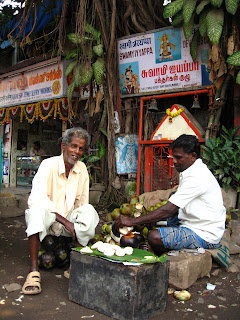

My experience thus far in Mumbai has encouraged me to ponder and act in ways that I have not previously been compelled to comport myself. The brazen attitude that one must adopt in order to board a second-class coach during rush hour is something that you cannot develop prior to actually being here. The adjustment to sheer volume of human beings takes some time. In fact, perhaps living in such a congested, clogged, and crowded metropolis might not be at all desirable in the long term. However, the human truths that can be accumulated by living the metropolitan grind are so far worth the struggle.
Density...is the first reality with which one must become accustomed in this town. With a metro population of around 18 million bodies, that's something like 36 million each of ears, eyes, and kidneys. 180 million toes and fingers. 18 million souls. The average density in Greater Mumbai, which is the name given to the city itself and which does not include the population of the whole urban agglomeration, is something like 40,000 inhabitants per square kilometer. This absolutely staggering density of human habitation, while not close to the 170,000 inhabitants per square kilometer in the Lower East Side of NY in 1905, is considerably higher than 50,000 people per sqkm in many parts of the city. While sheer volume of people is no way to judge quality of life or ease of transport throughout a city, the congestion that plagues Mumbai is a function of a vast inability to cope with staggering population growth.
Map of Population Density by Country
Selected Urban Population Densities
Of three other world cities whose population densities in certain incredibly packed areas rival Mumbai's (Hong Kong, Cairo, and Shanghai), perhaps only Cairo would strike the average visitor as more overwhelming, due to a number of factors, including poverty stats, crime, and general overcrowding. Yet, Mumbai does not have a crime problem. Crime is a subject that will be dealt with in later entries, but for all intents and purposes, crime is not on the short list of perennial urban difficulties in India. Poverty and general overcrowding top the list of most daunting urban challenges in this Island City. Mumbai is strikingly civil, despite its chaotic traffic interchanges, overflowing trains, and reckless rickshaws. The humans who inhabit this dazzling metropolis do not carry on with the sort of anger and embitterment that would characterize a city inhabited by New Yorker-Americans in a town almost 1/4 the size of New York, at the gateway to a country with well over 3X the population of the United States, with an area less than 1/3 the size of the continental US. Americans would kill each other if they were confined to conditions that Indians tolerate. Period. A tiny fraction of the space. A tiny fraction of the wealth. Yet, Indians get by, eking out lives with their big hearts and impossibly charming demeanors.

Divisions...by caste and religion, age and gender, language and education are astounding. Indians, contrary to what foreigners usually expect when coming to India, are of a range of divergent types. The demographic divisions that separate Indians from each other are on a level that Westerners often cannot appreciate. The endless list of tribes (7% of the overall population), formerly untouchable "Dalit" castes (16%) are positively endless. The manner with which a woman folds her saree and how a man conducts his head wiggle and where one goes to acknowledge humility before a higher power are things that vary with inconceivable range.
Diversity...is a gift and a curse. While Indians have experienced a horrific calamity several times - first and most notably during the Partition with Pakistan in 1947, the dream of a unified cultural whole lives on. Whether unified behind the notion of Hindutva or behind the national cricketeer squad, somehow the nation clunks along as a mostly coherent amalgamation of socio-linguistic communities. The several thousands of caste groups (jatis) retain the sense of tribal distinctiveness that was more or less always a part of life on the subcontinent, yet this ancestral heritage is in certain key ways losing its grip on the modernizing, globalizing, and Indianizing system. India works. India works hard. She works hard to make progress as a cohesive expression of national will. I have no concept of how this is possible. What sort of cultural constitution makes this possible at such a grand scale? Although China has several hundred million more people, I dare say India's task of keeping its far more variegated communities unified is a far more improbable task.


Disparity...is a concept that Thomas Friedman recently attempted to address in a recent column on the release of a cheap new Tata motor vehicle that will aim to inundate first-time car purchasers with an unbeatable bargain. At a mere 1 lakh (100,000 Rupees = $2,500), this vehicle will permit masses of middle-class Indians to drive to work, drive to class, drive to the collective neoliberal paradise, which in other words, is a congested ecological catastrophe. While I have not always agreed with Friedman's often neocon and/or neoliberal tendencies, I found that his green streaks shone through on this piece. No, No, Tata
His fundamental point was that clean mass mobility must trump over the near-term rush to develop, market, and compete. Without more concern for the long-term consequences of increasingly clogged roadways, railways, and sidewalks, Mumbai will begin to burst. Cheaper cars will mean more demand for petroleum, more pollution, and more traffic. Although the egalitarian impulse embedded in all of us would have us believe that all Indians have the right to drive their own cars 25 miles a day wherever they please in the same careless way that Americans parade their motor vehicles around asphalt mazes. But, the plain truth is that if all Indians were granted this so-called right to own a car, India would cease to be. I agree with Friedman's assertion that Indians must somehow jump over the car step in the evolution of transport. Build more rail lines, enact legislation to decrease the number of vehicles permitted into the city, and reverse densification-redevelopment policies that threaten to destroy any remaining semblance of urban sanity.

Dolor, depravity, destruction, delapidation...find their way into Dharavi's complex existence because this heart-shaped area of the city is Asia's biggest slum, by most estimates. Slum life is a mode of survival, reproduction, and employment unto itself - entirely the topic of another entry. But, the dreadful extremes that exist in Mumbai are embodied by the continued prosperity of its notoriously gargantuan slum. After two visits to this vibrant disaster, I have simply become more confused about human suffering and about man's capacity to cope with the most disgusting and degraded circumstances. Dharavi is Mumbai at its best and its worst. Mumbai gone horribly wrong yet Mumbai that tries, triumphs, and turns over. Another day, another dollar and a dream.




No comments:
Post a Comment